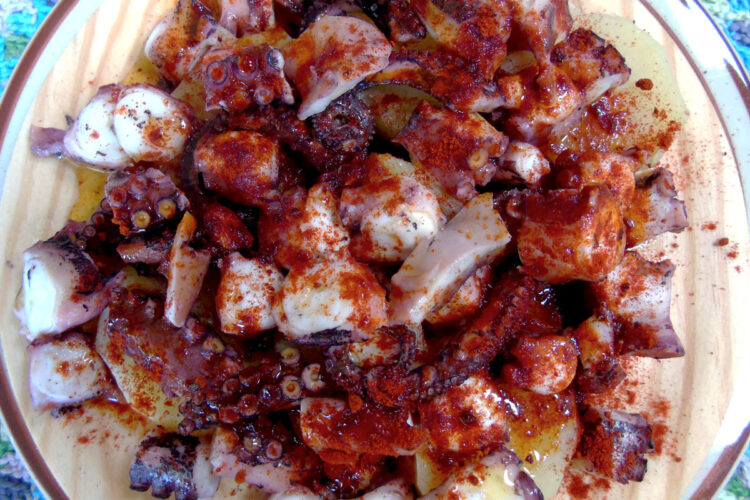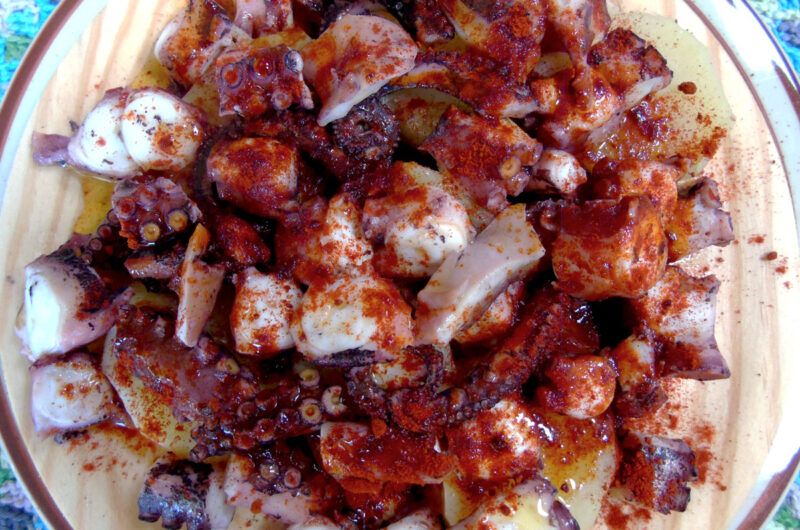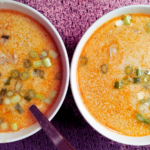As I mentioned in my blog post about Galicia, pulpo (or octopus in English), is considered a delicacy in the area. The way it is cooked, they have called it pulpo a feira in Galicia, and pulpo a la gallega in Spain. It is a tradition carried on from generation to generation. Here in Wales, we normally get our octopus from a small Portuguese shop frozen. Getting it frozen is very convenient as the freezing process tenderises the meat. It needs to sit in the fridge for at least two days to properly defrost. If you buy it fresh, you need to freeze it for about two weeks in order to be able to make this dish. So you need to prepare way ahead.
The tradition dictates to serve pulpo a feira on wooden plates with boiled potatoes, and sprinkled over with extra virgin olive oil, coarse sea salt and smoked paprika powder.
But why would you want to eat such a peculiar creature? Octopus meat is full of healthy Omega-3 fatty acids and contains very low amounts of saturated fat. It also contains protein, iron and other useful vitamins and minerals.
Pulpo a feira
Course: LunchCuisine: SpanishDifficulty: Medium8
servings400
kcal48
hours2
hoursWant to try something very different to serve on a special occasion that is naturally gluten free? This traditional Spanish dish mainly made of octopus and potatoes, will make an impression when done right.
You may want to buy the octopus fresh but you’re required to freeze it for at least two weeks before cooking to make it edible. When bought frozen, the freezing process already has tenderised the meat, ready for action. It needs to sit in the fridge for at least two days to properly defrost.
Pulpo a feira is normally served on wooden plates with boiled potatoes, and sprinkled over with extra virgin olive oil, coarse sea salt and smoked paprika powder.
Ingredients
1 large frozen octopus (approx. 2.5 kg), thawed overnight in the refrigerator
4-5 litres water, depending on the size of the octopus
1 tbsp coarse salt
500 g potatoes
100 ml extra virgin olive oil
2 tbsp smoked paprika powder
Directions
- In a large pot, bring water to a boil.
- While the water is heating, rinse the thawed octopus under running cold water. Using sharp kitchen scissors, cut out the mouth and the eyes.
- Pierce the body of the octopus with a long fork to get a good grip and dip it into the boiling water. Lift it out immediately and, when the water returns to a boil, dip it in briefly again.
- Repeat this dipping procedure three times or until the tentacles have curled. Submerge the octopus in water and let it boil over medium heat for about 1-2 hours, depending on the weight of the octopus, approximately 20 minutes per 1 kg.
- Wash and peel the potatoes and boil in a separate pot.
- Once the meat is tender, turn off the heat and let the octopus rest in the water for about 10 minutes.
- Lift and drain the octopus, cut into pieces with the kitchen scissors: the tentacles into 1-1.5 cm thick rings and the body into similar size pieces.
- Cut the boiled potatoes into sectors and spread evenly on wooden plates, spread the octopus pieces evenly on top. Sprinkle over with the olive oil, remaining coarse sea salt and paprika. Serve immediately. Enjoy!
Notes
- Don’t throw away the leftover liquid from boiling the octopus. It is a nice stock, perfect for boiling next batches of potatoes to give them some more taste or as basis for soup. You can keep it in the fridge and use it up to a week. You can also freeze the stock and save it for later.
Please use the hashtag #TheNonGlutenOne if you make this recipe so I can re-share the love. And do let me know if there’s anything wrong with this recipe. Use my contact page or email me info@thenonglutenone.com.







